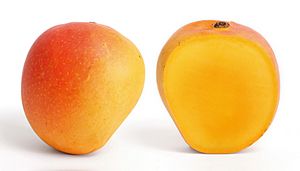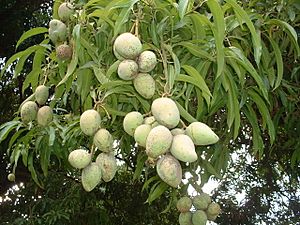List of mango cultivars facts for kids
A mango cultivar is like a special type or "breed" of mango plant that people have grown and chosen for its unique fruits. Think of it like different kinds of apples, such as Gala or Fuji – they are all apples, but they have different tastes, sizes, and colors. Around the world, there are hundreds of different mango cultivars!
Most of the mangoes you see in stores come from a species called Mangifera indica. But in places like Southeast Asia, you might find other types of mangoes from different Mangifera species. Many countries, including Australia, the United States, and some in Africa, grow their own special local mangoes. However, many other countries grow mango types that were first developed in Florida, USA.
Contents
Discovering Mango Varieties: A Sweet Journey
The United States Department of Agriculture (USDA) has a huge collection of mango varieties in Florida, with about 400 different types! This makes it one of the biggest places in the world for mango plant collections. Florida is a great spot for mangoes because of its warm weather all year. People there are really interested in mangoes, and many nurseries work to bring new types into the US or create new ones through special breeding.
Many of the mangoes you find in grocery stores in the United States can be traced back to a single mango tree called the Haden mango. This tree was planted way back in 1902 in Coral Gables, Florida. The Haden mango itself came from a mango called Malgova, which originated in India.
Here are some of the most popular mango cultivars, listed by where they were first chosen or are grown the most:
| Common name(s) |
Image | Origin/ region |
Notes |
|---|---|---|---|
| Alampur Baneshan |  |
India | |
| Alice |  |
United States | |
| Alphonso | 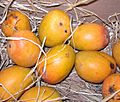 |
India | Often called the "King of mangoes," this mango is very sweet with no stringy bits. It's full of vitamins A and C. You'll find it mainly in the Raigad and Ratnagiri Districts of Maharashtra, India, from February to May. |
| Amrapali |  |
India | This mango is a mix of Dasheri and Neelum mangoes. It's known for its great taste and strong smell. Unlike some other mangoes, it produces fruit every year. |
| Anderson |  |
United States | The Anderson mango is a large fruit, growing up to 34 cm long. It came from a Sandersha mango seed planted in Miami, Florida. |
| Angie |  |
United States (Florida) | Angie mango trees are small and known for their great taste. They have a slightly strong, unique flavor. This mango is usually good at resisting diseases, but in very humid places, its new leaves can get a mango scab. |
| Anwar Ratol |  |
Pakistan (Punjab), India (Uttar Pradesh) | The Anwar Ratol is a small, yellow mango, sometimes called a "mini power house." It's very sweet with few stringy bits. |
| Ataulfo | 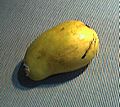 |
Brazil, Ecuador, Mexico | |
| Badami |  |
India (Karnataka) | Badami mangoes are also known as the Alphonso of Karnataka state. |
| Bailey's Marvel |  |
United States | |
| Banganapalle |  |
India (Andhra Pradesh) | This mango comes from the old princely state of Banganapalle in India. It's oval-shaped, about 20 cm long, with yellow flesh and smooth, thin yellow skin. The flesh is firm, meaty, sweet, and has no stringy bits. |
| Bangalora | India | It is also known as Kilimooku mangoes. | |
| Bennet Alphonso |  |
United States | |
| Beverly |  |
United States | Beverly is a late-season mango with almost no stringy bits, grown in South Florida. It produces fruit from August to October. |
| Black and Rose |  |
India (Kerala) | Black and Rose. |
| Bombay | 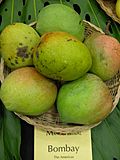 |
India, United States | The Bombay mango tree grows strongly and produces fruit in June–July in South Florida. It can easily get a disease called anthracnose. |
| Brahm Kai Meu |  |
United States | |
| Brooks |  |
Australia, United States | |
| Carabao (Philippine Mango) | 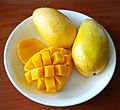 |
Philippines | The Ataulfo and Manilita mangoes came from this Philippine variety. Its history goes back to the Manila-Mexico galleon trade in the 1600s–1800s. |
| Carrie |  |
United States | The Carrie mango was named after Carrie Zill. It turns slightly yellow when ripe. It has a strong, unique flavor that some people love and others don't. It tastes best when it ripens on the tree. |
| Chaunsa |  |
India, Pakistan | Chaunsa is a pale yellow, slightly green mango when it's almost ripe. When it's fully ripe, its skin becomes a bit wrinkly and soft. It's harvested in the summer months (June–September). |
| Chinna rasalu | India (Nuzvid, Andhra Pradesh) | ||
| Cherukurasamu | India (Nuzvid, Andhra Pradesh) | ||
| Coconut Cream | United States | The Coconut Cream mango is a special type from Zills High Performance. Its fruit tastes like coconut cream pie! The tree's branches grow in interesting curves. | |
| Chok Anan |  |
Pakistan, Bangladesh, India, Thailand | Chok Anan is known as the "ever-bearing" mango tree because it can produce mangoes in both summer and winter. |
| Cogshall |  |
United States | Cogshall mangoes are excellent to eat, but they don't last long after being picked and have thin skin that bruises easily. |
| Cushman |  |
United States | |
| Dasheri |  |
India, Nepal, Pakistan | This mango started in a village called Dasehri in India. The original Dasehri mango tree is still alive and producing fruit, estimated to be 200-300 years old! It's a very good quality mango, grown for export. |
| Dot |  |
United States | Dot is an amazing tasting mango. It came from a Carrie Mango seed. However, the Dot mango can easily get a disease called anthracnose, so it's not good to plant it in very humid places. |
| Dudhiya Malda, Malda or Maldeo | India (Bihar), Nepal | This famous mango from Patna, India, is sometimes called the "King of Mangoes." It's known for being very sweet, having thin skin, small seeds, few stringy bits, and a unique sweet smell. People say it's irrigated with milk, and when you scratch its skin, a milk-like liquid comes out. | |
| Duncan |  |
United States | The Duncan mango was patented a long time ago. It grows in bunches and is very good at resisting diseases. It's a mid-to-late season mango. |
| Earlygold |  |
United States | |
| Edward |  |
United States | Edward is an excellent mango to eat, but the tree doesn't produce much fruit. |
| Eldon |  |
United States | |
| Emerald | United States | ||
| Espada | Brazil | ||
| Fazli (mango) |  |
Bangladesh (Rajshahi), India | The Fazli mango is mainly grown in Bangladesh and West Bengal, India. It's a late-ripening fruit, available after other types. Fazlis are often used to make jams and pickles. Each mango can be very large, up to a kilogram! |
| Fajri Kalan | Pakistan | ||
| Fairchild |  |
United States | |
| Fascell |  |
United States | The Fascell mango was patented in 1941 and is considered good to eat. |
| Florigon |  |
United States | The Florigon tree grows strongly. It's considered one of the best mango varieties for resisting diseases in humid climates, even if its flavor isn't as strong as some newer types. |
| Ford |  |
United States | |
| Gary |  |
United States | Many people think the Gary mango is delicious, with a hint of coconut flavor. However, it can easily get a disease called anthracnose. |
| Gir Kesar |  |
India, United Arab Emirates | The Gir Kesar mango is famous for its color and amazing smell. Ripe fruit has a wonderful smell and taste, which makes them expensive. |
| Glenn |  |
Italy, United States | Glenn is a sweet, mild mango. The tree grows to a medium size with a rounded shape. The ripe fruit has a very pleasant sweet smell. |
| Golapkhas/Gulabkhas | India | ||
| Gold Nugget |  |
United States | |
| Golden Lippens | United States | ||
| Graham |  |
Trinidad | Graham mangoes come from Trinidad. Compared to many modern mangoes, their flavor might seem a bit plain. |
| Green Willard | Sri Lanka, India | ||
| Haden |  |
India, Australia, Brazil, Costa Rica, Ecuador, Guatemala, Honduras, Mexico, United States | The Haden mango is the "parent" of many other mango varieties in the United States. The original Haden tree is still standing in Coral Gables, Florida. |
| Haribhanga | Bangladesh (Rangpur) | The Haribhanga mango is a popular type grown in Bangladesh. These mangoes are round and dark in color. They are very fleshy, have no stringy bits, and usually weigh 200 to 400 grams. | |
| Hatcher |  |
United States | |
| Heidi | South Africa | ||
| Himayat / Imam Pasand |  |
India | |
| Himsagar |  |
India (West Bengal), Bangladesh (Rajshahi) | The Himsagar mango is a popular type from Bangladesh and India. It's often called the "Champagne of mangoes." The inside is yellow to orange and has no stringy bits. It's a medium-sized fruit, weighing between 250 and 350 grams, and it stores well. It's also known as Khirsapati. |
| Ice Cream | United States | ||
| Irwin |  |
Australia, Costa Rica, United States, Taiwan, Japan (Okinawa) | In Japan, this variety is sold as "Apple Mango." |
| Ivory |
 |
China | Also called the Jingu Ivory mango, this long, thin mango looks like a young elephant's tusk. It has thin, smooth skin and very few stringy bits. It was brought to China from Thailand in 1914. |
| Jacquelin | United States | ||
| Jakarta |  |
United States | |
| Jean Ellen |  |
United States | |
| Julie |  |
Caribbean | A colorful, oval-shaped mango with almost flat sides. It has a sweet-tart flavor and grows on a small tree. It's very popular throughout the Caribbean. Julie mangoes have a lot of stringy bits. |
| Kalepad | India (Andhra Pradesh) | ||
| Gir Kesar | India (Kachchh) | ||
| Katchamitha |  |
India, Philippines | Katchamitha came from India but is now very common in the Philippines, where it's called "Indian mango." It's often eaten while still green and crunchy, with a slightly sweet taste. When ripe, its flesh has more stringy bits compared to the native Carabao mango. |
| Keitt |  |
Australia, Brazil, Costa Rica, Ecuador, Italy, South Africa, United States | Keitt is one of the latest-season mangoes in South Florida, with fruit available into October. Backyard Keitts can often weigh up to 2 pounds, and sometimes even 5 pounds! |
| Kensington Pride |  |
Australia, Italy, United States | |
| Kent |  |
Australia, Brazil, Ecuador, Guatemala, Honduras, Israel, Italy, Mexico, South Africa, United States | The original Kent tree is still standing in Coral Gables, Florida, USA. |
| Kohu Amba | Sri Lanka | ||
| Kothapalli Kobbari | India (Pithapuram, Andhra Pradesh) | Also known as Kobbari Mamidi. | |
| Lakshmanbhog | India | ||
| Lancetilla |  |
Honduras, United States | Lancetilla can produce very large fruits, up to 5 pounds, but many mango experts don't think its eating quality is the best. The fruit can also split open on the tree. |
| Langra |  |
India, Pakistan, Bangladesh | |
| Lemon Meringue | Myanmar | ||
| Lippens |  |
United States | |
| Madame Francis |  |
Haiti | A large, kidney-shaped mango that turns golden yellow when ripe. It has a tangy flesh and is very popular in the Caribbean. Madame Francis mangoes have a lot of stringy bits. |
| Mahachanok | Asia, United States | Mahachanok is a long, commercial mango from Asia, with a yellow to orange skin when ripe. It's described as sweet, pleasant, and without stringy bits. | |
| Mallika |  |
India, Nepal, United States | |
| Malwana (mango) | Sri Lanka | ||
| Manilita | United States | ||
| Manohar | India (Punjab) | A large mango that grows in bunches. It has an excellent, complex flavor and is very sweet. The tree grows very strongly. | |
| Momi K | Hawaii, United States | This mango is teardrop-shaped with a narrow point. It ripens to a reddish-orange color. The flesh has a creamy texture. | |
| Muhammad Wala | Pakistan | ||
| Mulgoba |  |
India, United States | A small mango with a relatively large seed. It is the parent of the Haden mango. |
| Nam Doc Mai |   |
Thailand, United Arab Emirates | The fruit is long, with a noticeable "beak," and is usually yellow with green spots. |
| Neelam |  |
India, Pakistan | Neelam mangoes are smooth-skinned and bright yellow when ripe. The flesh is deep yellow to orange, with no stringy bits and a rich, strong flavor. They ripen late in the season and can be stored for a long time. |
| Osteen | 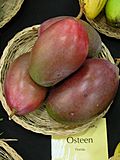 |
Italy, Spain, United States | |
| Owais | Egypt | ||
| Paige | |||
| Palmer |  |
Australia, Brazil, United States | |
| Panakalu | India (Andhra Pradesh) | ||
| Panchadharakalasa | India (Andhra Pradesh) | This is a juicy mango variety from India. Its name means "sugar pot" in Telugu, referring to its sweetness. | |
| Paraíso | Mexico | ||
| Parvin |  |
United States | |
| Piña Colada | United States | The Piña Colada mango is part of a special breeding program. It's a small fruit with a lot of flavor. However, the tree doesn't produce much fruit and can easily get anthracnose disease. | |
| Peddarasamu | India (Nuzvid, Andhra Pradesh) | ||
| Philippine | See Carabao (mango). | ||
| Pickering | |||
| Pico |  |
Philippines | Along with the Carabao mango, this is one of the most common mangoes grown in the Philippines. It has long fruits with a noticeable "beak" and is light orange when ripe. The flesh is rich orange to red, sweet, and has short stringy bits. |
| Pim Seng Mun | |||
| Pineapple Pleasure | |||
| Po Pyu Kalay | Myanmar | ||
| Pram Kai Mea | See Brahm Kai Meu. | ||
| Raspuri |  |
India (Karnataka) | An extremely popular variety in South India. A fully ripe Raspuri can produce a lot of juice! |
| Red Willard | Sri Lanka | ||
| Rosa | Brazil | The Rosa ("pink") mango is common in Northeast Brazil. It's very sweet but also very fibrous, so it's mostly used for juices or desserts. | |
| Rosigold |  |
United States | Rosigold is one of the earliest mangoes available in South Florida. Its quality is considered average, but it's special because it's available when no other fresh mangoes are around. It can easily get anthracnose disease. |
| Ruby |  |
United States | |
| Ryan | |||
| Saigon | 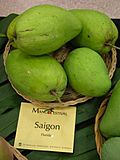 |
United States | |
| San Felipe | 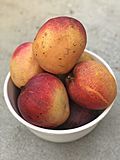 |
Cuba | This fruit is large, weighing about 20 ounces, with a striking dark red color. The flesh is yellow. |
| Saharni | Pakistan | ||
| Sammar Bahisht | Pakistan, India | (In Urdu, Sammar means fruit and Bahisht means Paradise). | |
| Sensation |  |
South Africa, United States | |
| Shan-e-Khuda |  |
Pakistan | |
| Sindhri |  |
Mirpur Khas district, Sindh province of Pakistan | This mango is very fragrant and sweet. Its flesh is soft, smooth, and orange when fully ripe. Some people enjoy it as is, while others prefer to eat it before it's fully ripe for a bit more sourness. |
| Sophie Fry |  |
United States | |
| Southern Blush | United States | ||
| Spirit of '76 | United States | The Spirit of '76 mango has no stringy bits and a very pleasant sweet flavor. | |
| Springfels |  |
United States | This is an older mango variety from Florida, but it still tastes good. It's a large mango, but because of its size, it can ripen unevenly. This uneven ripening is sometimes called "jelly seed," where the flesh around the seed becomes overripe and soft. |
| Sunrise | |||
| Sunset |  |
United States | |
| Swarnarekha | India (Andhra Pradesh) | ||
| Sweet Tart | |||
| Tess Pollok | |||
| Tommy Atkins |  |
Brazil, Costa Rica, Ecuador, Guatemala, Honduras, Israel, Italy, Mexico, South Africa, United Arab Emirates, United States, Venezuela | This is one of the most commonly sold mangoes in the world. It has a very long shelf life. |
| Torbert | United States | ||
| Totapuri |  |
India | |
| Turpentine |  |
United States | Turpentine is a small mango with a lot of stringy bits. It's often used in Florida for grafting other mango varieties onto its roots. |
| Ugly Betty | |||
| Valencia Pride |  |
South Africa, United States | A large, long mango with a sweet, mild flavor. However, the fruit can split open on the tree. The tree itself grows very strongly. |
| Van Dyke |  |
Italy, United States | |
| Vellai Kolomban | Sri Lanka | ||
| Young | United States | The Young mango was renamed "Tebow" (after a famous American football player) for marketing. | |
| Zill |  |
South Africa, United States | The Zill mango tree grows strongly, and its fruit is good to eat. |
Mangoes Around the World: A Country-by-Country Guide
Mangoes are grown in many different countries, and each place often has its own special varieties. Here's a look at some of the popular mangoes found in different parts of the world:
Mangoes in Asia
- Bangladesh: Amrapali, Haribhanga, Himsagar, Langra, Chokanan, Fazli, Mohanbhog, Ashwina.
- Cambodia: Cambodiana.
- China: Baiyu, Guixiang, Huangpi, Huangyu, Macheco, Sannian, Yuexi.
- India: Alphonso, Amrapali, Alampur Baneshan, Fazli, Langra, Banganapalle, Black and Rose, Bombay, Chausa, Dasheri, Dudhiya Malda, Himsagar, Imam Pasand, Gir Kesar, Mallika, Neelum, Raspuri, Totapuri.
- Indonesia: Arumanis/Harumanis, Gadung/Gedong, Manalagi, Mangga Madu, Cengkir/Indramayu, Gajah, Kueni, Golek.
- Japan (Okinawa): Irwin.
- Malaysia: Apple Mango, Apple Rumani, Arumanis, Golek, Malgoa.
- Myanmar: Aung Din, Ma Chit Su, Po Pyu Kalay, Sein Ta Lone, Shwe Hin Tha.
- Nepal: Alphonso, Amrapali, Dusehri, Bombay, Mallika.
- Pakistan: Almaas, Alphonso, Anwar Rataul, BaganPali, Chaunsa, Chok Anan, Dusehri, Fajri, Langra, Malda, Neelum, Sindhri, Shan-e-Khuda.
- Philippines: Apple mango, Carabao, Katchamitha ("Indian"), Pico.
- Singapore: Apple Mango, Arumanis, Golek, Kaem Yao.
- Sri Lanka: Dampara, Hingurakgoda, Karutha Kolomban, Malwana, Vellai Kolomban, Willard.
- Taiwan: JinHwang, Red JinHwang, TaiNong No. 1, Irwin.
- Thailand: Kaeo 007, Kratae Luemrang, Krasuay, Kluay, Kalonthong, Kampan, Khiaosawoey, Chok Anan, Nam Doc Mai, Okrong.
- Vietnam: Cao Lãnh Cát Chu mango, Bình Định Elephant mango, Hoà Lộc Sand mango.
Mangoes in Oceania
- Australia: B74 (also called Calypso), Brooks, Haden, Irwin, Keitt, Kensington Pride, Kent, Nam Doc Mai, Palmer, R2E2, Honey Gold.
- Hawaii: Hawaiian Common, Gouveia, Hawaiian Dwarf, Momi K, Pope, Rapoza, Sugai, Turpentine.
Mangoes in Africa
- Cameroon: Améliorée du Cameroun.
- Egypt: Alphonso, Hindi, Beid El Agl, Oweisi, Taymoor, Zebdiah, Mesk, Kit, Kent, Naomi, R2, Haidy, Sedika.
- Kenya: Apple Mango, Batwi, Boubo, Ngowe.
- Mali: Amelie, Kent.
- Réunion island: Carotte, Jose, Lucie, Auguste.
- South Africa: Fascell, Haden, Keitt, Kent, Sensation, Tommy Atkins, Zill.
- Sudan: Alphonso, Bez el-Anza, Oweisi, Taymoor.
- Tanzania: Boribo Muyini, Dodo, Mawazo, Sindano.
- Zambia: Heidi, Kent, Sensation, Tommy.
Mangoes in the Americas
- Brazil: Coquinho, Haden, Espada, Keitt, Kent, Rosa, Palmer, Tommy Atkins.
- Costa Rica: Haden, Irwin, Keitt, Mora, Tommy Atkins.
- Cuba: San Felipe, Prieto, Toledo.
- Ecuador: Ambassador, Alphonso, Ataulfo, Haden, Julie, Keitt, Kent, Reina, Tommy Atkins.
- Guatemala: Haden, Kent, Tommy Atkins.
- Haiti: Francine (Madame Francis), Muscas, Labiche, Baptiste, Rosalie.
- Honduras: Haden, Kent, Lancetilla, Tommy Atkins.
- Mexico: Ataulfo, Haden, Irwin, Kent, Manila, Palmer, Sensation, Tommy Atkins.
- Peru: Criollos, Haden, Keitt, Kent, Tommy Atkins.
- Suriname: Rood borsje, Tetéé.
- United States (California): Keitt, Haden, Timotayo, Manila.
- United States (Florida): Alampur Baneshan, Alice, Alphonso, Anderson, Angie, Bailey's Marvel, Beverly, Bombay, Brahm Kai Meu, Brooks, Carabao, Carrie, Chok Anan, Cogshall, Cushman, Dot, Duncan, Earlygold, Edward, Eldon, Emerald, Fairchild, Fascell, Florigon, Ford, Gary, Glenn, Gold Nugget, Golden Lippens, Graham, Haden, Hatcher, Ice Cream, Irwin, Ivory, Jakarta, Jean Ellen, Julie, Keitt, Kensington Pride, Kent, Lancetilla, Lippens, Mallika, Manilita, Mulgoba, Nam Doc Mai, Neelum, Osteen, Palmer, Parvin, Piña Colada, Pickering, Po Pyu Kalay, Rosigold, Ruby, Saigon, Sensation, Sophie Fry, Southern Blush, Spirit of '76, Springfels, Sunset, Tommy Atkins, Turpentine, Valencia Pride, Van Dyke, Zill.
- Venezuela: Haden, Keitt, Kent, Tommy Atkins.
- West Indies: Amélie, Black (blackie), Bombay, Dou-douce, East Indian, Graham, Haden, Julie (St. Julian), Long, Madame Francis, Rose, Spice-Box, Starch.
Mangoes in Europe
- Italy: Kensington Pride, Glenn, Tommy Atkins, Keitt, Maya, Van Dyke, Osteen, Kent.
- Malta: Keitt, Maya, Kensington Pride, Glenn, Irwin.
Mangoes in the Middle East
- Egypt: Zebda, Mesk, Awais, Qalb el tor, Mabrouka, Sennara, Taymour.
- Israel: Haden, Omer, Orly, Shelley, Keitt, Kent, Maya, Nimrod, Palmer, Tommy Atkins.
- Yemen: Taimoor, Abu Sanarah, Hafoos, Al Fawnas, Al Bameli, Al Burkani, Sudanese, Abu Samakah.
See also
- International Code of Nomenclature for Cultivated Plants


